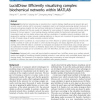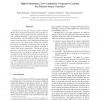38 search results - page 3 / 8 » The role of diameter in the controllability of complex netwo... |
BMCBI
2010
13 years 5 months ago
2010
Background: Biochemical networks play an essential role in systems biology. Rapidly growing network data and e research activities call for convenient visualization tools to aid i...
AIPS
2003
13 years 7 months ago
2003
Grid computing gives users access to widely distributed networks of computing resources to solve large-scale tasks such as scientific computation. These tasks are defined as stand...
WINET
2011
13 years 21 days ago
2011
During the last decade, Wireless Sensor Networks (WSNs) have emerged and matured at such point that currently support several applications like environment control, intelligent bu...
HPCA
2009
IEEE
14 years 6 months ago
2009
IEEE
Interconnection plays an important role in performance and power of CMP designs using deep sub-micron technology. The network-on-chip (NoCs) has been proposed as a scalable and hi...
SASN
2006
ACM
13 years 11 months ago
2006
ACM
Wireless sensor networks are typically deployed to measure the information field, rather than create an information field. However, by utilizing the radio on sensor nodes, it is...


